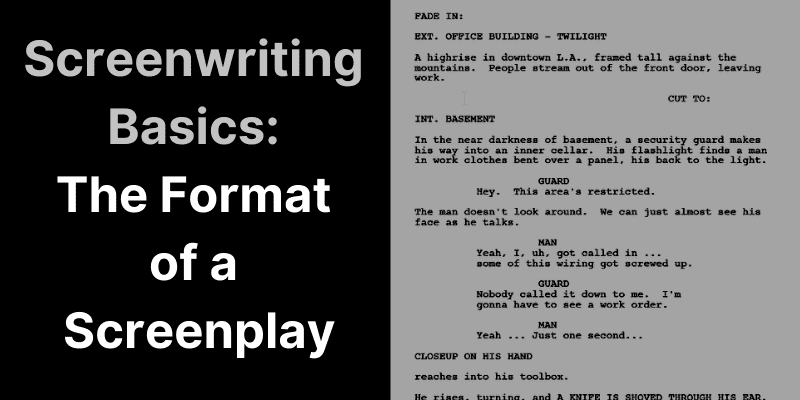
From Idea to Page: A Journey Through Writing Your First Script
Writing your first screenplay can be a daunting task, but it’s also an exciting opportunity to bring your creative ideas to life. It’s a chance to develop characters, create worlds, and tell stories that can captivate and inspire audiences. However, it can also be overwhelming to navigate the screenwriting process, particularly if you’re new to the craft. In this post, we’ll take a journey through the experience of writing your first script, from coming up with an idea to putting the finishing touches on your final draft. Whether you’re a first-time screenwriter or an experienced writer looking to tackle a new medium, this guide will help you navigate the exciting and challenging world of screenwriting.
Finding Inspiration: Where to Look for Ideas and How to Develop Them

Inspiration can come from a variety of sources, including your own life experiences, the world around you, and the stories you love. Some writers draw on personal experiences to craft stories that are deeply personal and meaningful, while others find inspiration in current events or social issues. Still, others turn to books, movies, or TV shows they love to create something new and unique. Take some time to explore your own interests and passions, and think about what themes and stories resonate with you the most.
Once you have a general idea for your script, it’s important to develop it into a more detailed concept. This involves brainstorming, researching, and exploring different angles and approaches to your story. Consider questions like: What is the central conflict of the story? Who are the main characters, and what motivates them? What are the stakes of the story, and what is at risk for the characters? As you work through these questions, you may find that your original idea evolves and changes, becoming something more complex and nuanced.
One helpful exercise for developing your story is to create a “logline,” or a brief summary of the plot that captures the essence of your story in a single sentence. This can be a useful tool for clarifying your concept and keeping your story focused as you work on the script. Additionally, you can use visual aids like storyboards, mind maps, or character sketches to help flesh out your ideas and bring your story to life.
Don’t be afraid to draw on your own emotions and experiences as you develop your script. Some of the most compelling stories come from writers who are able to tap into their own personal struggles and triumphs, and translate them into universal themes and experiences that resonate with audiences. However, it’s also important to remember that not every story needs to be autobiographical, and that there is value in exploring topics and perspectives that are different from your own.
Remember that inspiration can strike at any time, so be open to new ideas and experiences. Keep a notebook or digital file handy to jot down any interesting ideas or observations you come across, and make a habit of seeking out new stories, perspectives, and experiences that can inform and enrich your writing. Whether it’s taking a new class, traveling to a new place, or simply reading a book outside of your usual genre, the more you expose yourself to new ideas and perspectives, the richer and more varied your writing will become.
In the end, finding inspiration is a deeply personal process, and what works for one writer may not work for another. However, by staying curious, exploring new ideas, and staying true to your own voice and vision, you can create stories that are uniquely your own, and that have the power to captivate and inspire audiences.
Understanding the Screenwriting Format: Structure, Dialogue, and Scene Description

Screenwriting is a highly structured form of writing that follows a specific set of rules and conventions. Understanding the format is key to writing a successful script that can be easily read and understood by others. Screenplays are typically divided into three acts, each with its own set of plot points and turning points that propel the story forward.
Within each act, scenes are organized using sluglines, which are brief descriptions of the location and time of day for each scene. Each scene also includes action descriptions, which describe the physical actions of the characters and the setting in which the action takes place. These descriptions should be concise and descriptive, conveying the tone and mood of the scene without overloading the reader with unnecessary detail.
Dialogue is another important aspect of screenwriting, and it should be used sparingly and purposefully. Each character should have a distinct voice and way of speaking, and their dialogue should reveal something about their personality, motivations, and relationships. Avoid exposition-heavy dialogue that feels forced or unnatural, and instead let the action and character interactions speak for themselves.
Another key aspect of the screenwriting format is the use of parentheticals, which are brief descriptions of the character’s tone of voice or physical actions. These should be used sparingly and only when necessary to clarify the character’s intentions or emotions. Be careful not to overuse parentheticals, as they can clutter the page and distract from the action and dialogue.
Formatting is essential to the readability of a screenplay. Use industry-standard software like Final Draft or Celtx to ensure that your script is properly formatted with the correct margins, spacing, and font. Use bold or italic text sparingly and only for emphasis, and avoid using all caps or underlining, as these can be distracting and make the script harder to read.
While understanding the screenwriting format may seem daunting at first, with practice and persistence, it will become second nature. Familiarize yourself with the conventions of the genre, read as many scripts as you can, and don’t be afraid to experiment with different approaches and styles. The more you write and revise, the more comfortable you will become with the format, and the more confident you will be in your ability to create compelling stories that can captivate and entertain audiences.
Mapping Out Your Story: Outlining and Planning Your Script

One of the most important steps in writing a screenplay is mapping out your story. This involves outlining the plot, developing the characters, and establishing the central conflict of the script. This initial planning stage is essential to creating a cohesive and engaging story that will keep audiences hooked from beginning to end.
Start by developing a general outline of the story, including the major plot points and turning points that will drive the narrative forward. This can be as simple as a bulleted list or as detailed as a full storyboard, depending on your personal style and preference. The key is to have a clear sense of the story’s structure and pacing before you begin writing the script.
Once you have a basic outline in place, it’s time to develop your characters. Who are the main players in your story, and what motivates them? What are their goals and desires, and how will they change over the course of the script? Fleshing out your characters in detail will help you create more believable and engaging characters that audiences will care about.
As you develop your characters, consider the central conflict of the story. What is at stake for your protagonist, and what obstacles will they need to overcome to achieve their goals? The conflict should be both clear and compelling, with high stakes that keep audiences invested in the story.
As you map out your story, don’t be afraid to experiment with different approaches and structures. Some writers prefer a more linear narrative, while others may choose to use flashbacks or non-linear storytelling to add complexity and depth to the story. Think about what structure will best serve your story and characters, and be willing to revise and adjust your outline as needed.
Keep in mind that mapping out your story is an ongoing process. As you write and revise your script, you may discover new plot twists or character developments that require you to adjust your outline. Stay flexible and open to new ideas, and be willing to revise your plan as needed to ensure that your story is as compelling and engaging as possible.
Writing Your First Draft: Tips for Getting Started and Staying Motivated

Here are six tips for writing your first draft:
- Set aside dedicated time each day to work on your script, and try to establish a routine that works for you.
- Before you begin writing, review your outline and ensure that you have a clear sense of the story and characters.
- Resist the urge to edit or revise as you go. Focus on getting your ideas down on paper and moving the story forward.
- Embrace imperfection and don’t worry if your dialogue or descriptions are rough around the edges.
- Find a writing buddy or support group to keep you motivated and on track.
- Remember that writing is a process, and your first draft is just the beginning. Celebrate your successes, learn from your mistakes, and keep pushing yourself to grow and improve as a writer.
Refining Your Work: Revising, Editing, and Getting Feedback

Revising and editing are crucial parts of the screenwriting process. Once you have completed your first draft, take some time away from your script before diving back in to revise. This break will allow you to come back to your work with fresh eyes and a more objective perspective.
As you revise your script, focus on tightening up the story, characters, and dialogue. Make sure that every scene is essential to the story and that every line of dialogue reveals something important about the characters or advances the plot.
Getting feedback from others can also be incredibly valuable in refining your work. Share your script with trusted friends or colleagues and ask for honest feedback. Listen to their suggestions and criticisms with an open mind, and use this feedback to improve your script.
When it comes to editing your script, pay attention to the details. Check for grammar and spelling errors, and make sure that your formatting is correct. A clean, polished script shows that you are a professional and serious about your craft.
Remember that refining your work is an ongoing process. Don’t be afraid to make changes and try new things as you revise and edit your script. With each pass, you will get closer to creating a polished, compelling screenplay that captures the heart of your story and engages your audience.
Next Steps: Submitting Your Script, Entering Contests, and Breaking into the Industry

Here are six steps for submitting your script, entering contests, and breaking into the industry:
- Polish your script until it’s the best it can be. Make sure it’s formatted correctly and free of spelling and grammar errors. Consider getting professional feedback on your script to help you refine it even further.
- Research potential agents, managers, and production companies to find ones that align with your style and interests. Submit your script to those that you feel would be a good fit.
- Enter reputable screenwriting contests. Winning a contest can give your script valuable exposure and help you make industry connections.
- Attend industry events, such as film festivals and screenwriting conferences, to network and learn from professionals in the field.
- Consider writing spec scripts for existing TV shows or movies. This can help you hone your craft and demonstrate your ability to write within existing frameworks.
- Be persistent and patient. Breaking into the industry can take time and effort, but if you’re passionate and dedicated, you can make it happen. Keep writing, refining your craft, and seeking out opportunities to showcase your work.
Related:
- How Do You Write A Commercial Movie?
- 10 Tips On How To Write Scripts Faster
- How To Write Dramatic Action